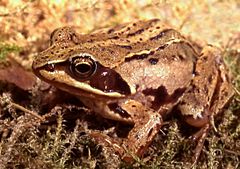Moor frog facts for kids
Quick facts for kids Moor frog |
|
|---|---|
 |
|
| Conservation status | |
| Scientific classification | |
| Kingdom: | |
| Phylum: | |
| Class: | |
| Order: | |
| Family: | |
| Genus: | |
| Species: |
R. arvalis
|
| Binomial name | |
| Rana arvalis Nilsson, 1842
|
|
The Moor Frog (Rana arvalis) is a type of frog that lives near water. It's a skinny, reddish-brown amphibian and belongs to the true frog family.
Contents
What They Look Like
Moor frogs are small. They often have a pale stripe down their back. They also have a big, dark spot near their ears.
These frogs are usually reddish-brown, but some can be yellow, gray, or light olive. Their bellies are white or yellow. They also have a black stripe that looks like a "bandit mask" from their nose to their ears.
Moor frogs are usually about 5.5 to 6.0 cm long. Some can grow up to 7.0 cm. Their heads are more pointed than those of the Common frog. Their skin is smooth on their sides and upper legs.
They have eyes with horizontal pupils. Their feet are partly webbed, which helps them swim. Their back legs are shorter than those of some other frog species. Male moor frogs have special rough pads on their first fingers. They also have two throat sacs that help them make loud calls.
Where They Live and Their Homes
Moor frogs live in many parts of Europe. You can find them from central and southern Europe all the way to Siberia. They live in countries like Austria, Belarus, Belgium, Czech Republic, Denmark, Estonia, Finland, France, Germany, Hungary, Italy, Latvia, Lithuania, Moldova, Netherlands, Norway, Poland, Romania, Russia, Slovakia, Slovenia, Sweden, and Ukraine.
They used to live in Switzerland, but they might not be there anymore. Some people think they might also be gone from Siberia. The western edge of their home is in Alsace, France.
Moor frogs can live in many different places. They are found in cold, treeless lands called tundra. They also live in forests, grasslands, and areas where forests meet grasslands. You can find them at the edges of forests and in open clearings. They also live in swamps, wet meadows, fields, and gardens. They prefer places that humans haven't changed much, like damp meadows and bogs. However, they can sometimes live in farm areas and even cities.
Their Life and Habits
Winter Sleep
Moor frogs go into a long sleep called hibernation. This happens sometime between September and June. The exact time depends on how cold their home is. Frogs in warmer, southern areas start hibernating later, around November or December. They wake up earlier, in February. Frogs in very cold, northern areas start sleeping sooner, in September. They wake up later, in June.
Reproduction
The mating season for moor frogs happens right after they wake up from hibernation. This is usually between March and June. Male frogs gather and make loud calls. Their calls sound like air escaping from an empty bottle underwater. It sounds like "waug...waug...waug."
For a few days during this season, male moor frogs can turn a bright blue color! This helps them attract females.
Female frogs lay their eggs very quickly. This usually happens over three to 28 days. Each female lays one or two groups of eggs. Each group can have between 500 and 3,000 eggs. They lay these eggs in warm, shallow water, like in ponds.
Life Cycle
Moor frog tadpoles change into young frogs between June and October. Young larvae are about 45 mm long. They are dark with tiny shiny dots. When they are tadpoles, they eat algae and small water bugs.
Adult frogs stop eating during the mating season. But at other times, they eat insects and other small invertebrates.
Images for kids
See also
 In Spanish: Rana campestre para niños
In Spanish: Rana campestre para niños





